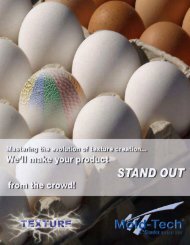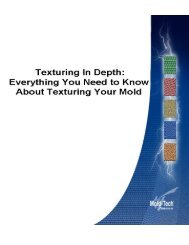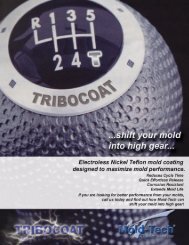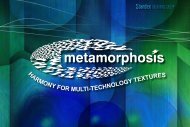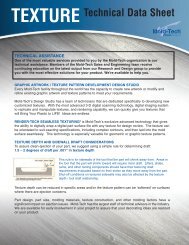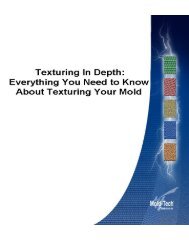TEXTURE Technical Data Sheet - Mold-Tech
TEXTURE Technical Data Sheet - Mold-Tech
TEXTURE Technical Data Sheet - Mold-Tech
Create successful ePaper yourself
Turn your PDF publications into a flip-book with our unique Google optimized e-Paper software.
<strong>TEXTURE</strong><br />
<strong><strong>Tech</strong>nical</strong> <strong>Data</strong> <strong>Sheet</strong><br />
TECHNICAL ASSISTANCE<br />
One of the most valuable services provided to you by the <strong>Mold</strong>-<strong>Tech</strong> organization is our<br />
technical assistance. Members of the <strong>Mold</strong>-<strong>Tech</strong> Sales and Engineering team receive<br />
continuing education on the latest output from our Research and Design group to provide<br />
you with the most effective solutions for your product. We’re available to help you.<br />
GRAPHIC ARTWORK / <strong>TEXTURE</strong> PATTERN DEVELOPMENT DESIGN STUDIO<br />
Every <strong>Mold</strong>-<strong>Tech</strong> facility throughout the world has the capacity to create new artwork or modify and<br />
refine existing graphic artwork and texture patterns to meet your requirements.<br />
<strong>Mold</strong>-<strong>Tech</strong>’s Design Studio has a team of technicians that are dedicated specifically to developing new<br />
customized textures. With the most advanced 3-D digital scanning technology, digital imaging system<br />
to replicate and manipulate textures, and rendering capability, we can quickly give you textures that<br />
will Bring Your Plastic to LIFE! Ideas are endless.<br />
RENDER-TECH SEAMLESS TEXTURING ® is <strong>Mold</strong>-<strong>Tech</strong>’s exclusive advanced technology that gives<br />
the ability to digitally wrap a digital part surface file with any texture for design review. The texture can<br />
be orientated to suit exacting specifications, including complex contours, and then laid into the mold<br />
surface seamlessly. This technology is especially valuable for geometric or graphic texture patterns.<br />
<strong>TEXTURE</strong> DEPTH AND SIDEWALL DRAFT CONSIDERATIONS<br />
To assure clean ejection of your part, we suggest using a simple rule for determining draft:<br />
1.5 – 2 degrees of draft per .001” in texture depth<br />
This rule is for sidewalls of the tool that the part will shrink away from. Areas in<br />
the tool that the part will shrink toward will require more draft. Lifters, slides,<br />
cams, and other tooling components should have their texturing draft<br />
requirements evaluated based on their action as they move away from the part.<br />
Shut-off conditions on textured sidewalls may also be affected by the texture<br />
depth / tool draft relationship.<br />
Texture depth can be reduced in specific areas and/or the texture pattern can be ‘softened’ on surfaces<br />
where there are ejection concerns.<br />
Part design, part size, molding materials, texture construction, and other molding factors have a<br />
significant impact on ejection issues. <strong>Mold</strong>-<strong>Tech</strong> has the largest staff of technical advisors in the industry.<br />
We are available for early involvement in your project to assure that your decorating ideas are realized<br />
on your product.
WHAT TOOLING MATERIALS CAN BE <strong>TEXTURE</strong>D?<br />
To assure that your molds are successfully textured, <strong>Mold</strong>-<strong>Tech</strong> has formulated the largest selection of mold<br />
etchants in the industry. Standard tool materials such as P-20, H-13, S-7, 01, A1, A2, A6, 420 stainless,<br />
beryllium copper, kirksite, forged, wrought and cast aluminums have all been textured successfully.<br />
Since your tooling material choices can significantly affect the texture appearance, <strong>Mold</strong>-<strong>Tech</strong>’s <strong><strong>Tech</strong>nical</strong><br />
Advisors are always available to discuss and test your specific material preferences.<br />
WHAT FINISH IS REQUIRED ON THE MOLD SURFACE FOR TEXTURING?<br />
To assure that your texture pattern shows clean and without any surface flaws, we recommend the<br />
following surface finishes:<br />
• 400 paper (SPI B-2) for textures less than .001” deep.<br />
• 400 stone (SPI C-2) for textures between .001” and .003” deep.<br />
• 320 stone (SPI C-3) for textures over .003” deep.<br />
HOW DO I SPECIFY GLOSS?<br />
Gloss on a part is typically measured with a 60 degree gloss meter. The gloss number represents the<br />
percentage of light that is reflected off of the part. The gloss on a part is the result of many factors<br />
coming together: molding material, tool temperature, material temperature, venting, cycle time, wall<br />
stock thickness, texture patterns, mold coatings, etc.<br />
<strong>Mold</strong>-<strong>Tech</strong> uses a variety of blast media to help set the final gloss on the mold surface. Each part has<br />
its own factors to consider – contact us to discuss specific needs, factors and expectations.<br />
With many gloss targets being pushed lower, <strong>Mold</strong>-<strong>Tech</strong> has developed a laser-generated micro overlay<br />
texture called MicroMatte – lowering gloss and giving a rich and realistic appearance to textures.<br />
WHAT ABOUT WELDING ON A SURFACE THAT WILL BE <strong>TEXTURE</strong>D?<br />
If you are considering welding on a surface that is to be textured, proper welding procedures will<br />
greatly increase the final outcome of the texture appearance.<br />
• The mold should be pre-heated prior to welding, welded while the mold is hot, and annealed after<br />
welding. Contact the steel supplier for proper welding procedures and weld rod material.<br />
Any difference in hardness, composition or texture structure in the welded area when compared to the<br />
parent metal tends to produce an irregularity in the texture appearance after etching. When proper<br />
welding procedures are followed, differences can be minimized and welds become easier to blend-in<br />
and repair to a very acceptable level.<br />
If you are unsure of the direction to proceed with welding, <strong>Mold</strong>-<strong>Tech</strong> can help – with decades of<br />
experience to draw from as well as relationships with the steel manufacturers and welders, we can<br />
help give you the latest information you need to achieve the best results.<br />
HOW DO I PREPARE MY MOLD FOR TEXTURING?<br />
1. Completely dis-assemble mold – only send components to be textured.<br />
2. Make sure that all seal-off (shut-off) areas are properly scribed.<br />
3. Remove all EDM scale from areas to be textured.<br />
4. To avoid shipping damage, please take care in packaging your shipment.<br />
MOLD-TECH IS THE WORLD’S LEADER IN TEXTURING.<br />
We have the technology, advanced development initiatives, and worldwide<br />
capacity to deliver quality texturing, on time, and cost effectively.<br />
You can count on <strong>Mold</strong>-<strong>Tech</strong>.<br />
w w w . m o l d - t e c h . c o m



